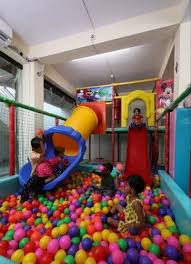
Exploring the Magic of Children’s Indoor Play Spaces
Exploring the Benefits of Children’s Indoor Play Areas
Children’s indoor play areas offer a wealth of benefits for young ones, providing a safe and stimulating environment for play and exploration. These vibrant spaces are designed to engage children in activities that promote physical, social, and cognitive development.
Physical Development
Indoor play areas often feature climbing structures, slides, and soft play equipment that encourage children to move their bodies and develop gross motor skills. These activities help improve coordination, balance, and strength while allowing children to expend energy in a fun and controlled environment.
Social Interaction
Playing in indoor settings allows children to interact with their peers, fostering social skills such as sharing, cooperation, and communication. Through group play activities, children learn valuable lessons in teamwork and develop friendships that can last a lifetime.
Cognitive Stimulation
Many indoor play areas incorporate educational elements into their design, such as puzzles, games, and creative workshops. These activities stimulate children’s minds, encouraging problem-solving skills, creativity, and imagination. By engaging in these cognitive challenges, children can enhance their learning abilities in a playful setting.
Safe Environment
Indoor play areas provide a controlled environment where children can explore and play without the risks associated with outdoor playgrounds. Soft padding, secure structures, and attentive staff ensure that children can have fun while staying safe from potential hazards.
Family Bonding
Visiting indoor play areas can be a great way for families to bond and spend quality time together. Parents can join in on the fun or relax in designated seating areas while watching their children explore and enjoy themselves. These experiences create lasting memories for both parents and kids.
In conclusion, children’s indoor play areas offer a host of benefits that contribute to the overall development and well-being of young ones. From physical activity to social interaction and cognitive stimulation, these spaces provide an enriching environment where children can learn through play. So next time you’re looking for a fun outing for your little ones, consider visiting a local indoor play area for an exciting adventure!
Frequently Asked Questions About Children’s Indoor Play Areas: Age Requirements, Safety, Supervision, Activities, Costs, and More
- What are the age requirements for children’s indoor play areas?
- Are there any safety measures in place at indoor play areas?
- Do parents or guardians need to supervise children at all times?
- What activities and facilities are available in children’s indoor play areas?
- Are food and drinks available, or can we bring our own?
- How much does it cost to enter a children’s indoor play area?
- Can we book the venue for birthday parties or private events?
- Are there any special sessions for children with disabilities or special needs?
What are the age requirements for children’s indoor play areas?
Age requirements for children’s indoor play areas can vary depending on the facility and the activities offered. Typically, indoor play areas cater to children between the ages of 1 to 12 years old, with designated zones or equipment tailored to different age groups. Some play areas may have specific restrictions or guidelines based on age for safety reasons and to ensure that all children can enjoy the space comfortably. It’s always a good idea to check with the individual play area regarding their age requirements to ensure that your child can fully participate in the activities available.
Are there any safety measures in place at indoor play areas?
Safety is a top priority at indoor play areas, with stringent measures in place to ensure the well-being of all children. These spaces are designed with safety in mind, featuring padded surfaces, secure structures, and age-appropriate equipment to minimise the risk of accidents. Trained staff members are always present to supervise and assist children as they play, enforcing rules and guidelines to maintain a safe environment. Regular maintenance checks and cleanliness protocols further contribute to the overall safety of indoor play areas, providing parents with peace of mind knowing that their little ones can enjoy themselves while being protected from potential hazards.
Do parents or guardians need to supervise children at all times?
Ensuring the safety and well-being of children is paramount in indoor play areas, and as such, parents or guardians are typically required to supervise their children at all times. While indoor play areas have dedicated staff members to oversee activities and assist when needed, parental supervision adds an extra layer of security and ensures that children are behaving appropriately and following the rules of the facility. By staying vigilant and engaged with their children’s play, parents can help create a positive and safe environment for all visitors to enjoy.
What activities and facilities are available in children’s indoor play areas?
Children’s indoor play areas offer a wide range of activities and facilities to keep young ones entertained and engaged. From climbing structures, slides, and ball pits to interactive games, creative workshops, and sensory play areas, there is no shortage of fun options for children to explore. Many indoor play areas also feature themed zones, role-playing corners, and educational activities that cater to various interests and age groups. Additionally, facilities such as soft padding for safety, seating areas for parents, and on-site cafes add to the overall experience, ensuring that families can enjoy a day of play in a comfortable and welcoming environment.
Are food and drinks available, or can we bring our own?
When it comes to children’s indoor play areas, the policy on food and drinks can vary from one establishment to another. Some indoor play areas may have cafes or snack bars on-site where you can purchase food and beverages for your little ones. In contrast, others may allow you to bring your own snacks and drinks to enjoy during your visit. It’s always a good idea to check the specific rules and regulations of the indoor play area you plan to visit regarding food and drink options to ensure a hassle-free and enjoyable experience for both you and your children.
How much does it cost to enter a children’s indoor play area?
The cost of entering a children’s indoor play area can vary depending on the location, facilities, and activities offered. Generally, admission fees typically range from a few pounds to a moderate price per child for a session of play. Some indoor play areas may offer discounted rates for siblings or special promotions during off-peak hours. It’s always a good idea to check the specific pricing details on the play area’s website or contact them directly to inquire about current entrance fees and any available discounts.
Can we book the venue for birthday parties or private events?
Many children’s indoor play areas offer the option to book the venue for birthday parties or private events, providing a fun and hassle-free setting for special celebrations. By reserving the space, parents can ensure exclusive access to the facilities and activities, creating a memorable experience for their child and their guests. With dedicated party packages that often include decorations, food options, and entertainment, hosting a birthday party or private event at a children’s indoor play area can be a convenient and enjoyable choice for families looking to celebrate in a vibrant and engaging environment.
Are there any special sessions for children with disabilities or special needs?
Many children’s indoor play areas offer special sessions tailored to accommodate children with disabilities or special needs. These sessions provide a supportive environment where every child can participate and enjoy the activities at their own pace. Trained staff members are often available to assist and ensure that all children feel included and comfortable during their playtime. These dedicated sessions aim to create an inclusive space where children of all abilities can engage in play, fostering a sense of belonging and acceptance within the community.



